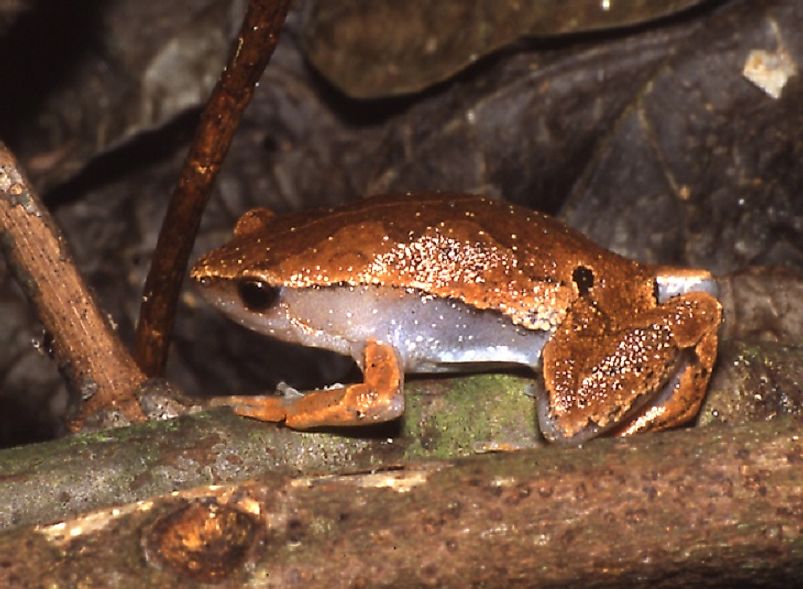Amphibian Species Of Ecuador

Ecuador is a beautiful country with a diverse landscape, ranging from Amazon rainforests to the Andean highlands to the islands of Galapagos. Ecuador is home to over 580 species of amphibians, the third-highest number in the world after Brazil and Colombia. Ecuador has the highest wealth of amphibians per unit area, with two species per 1,000 square kilometers. Despite the high number of amphibian species in the country, the nature of the amphibians and difficulty in accessing their habitats, the Ecuadorian amphibians are unknown to most people. Some of the amphibian species of Ecuador are looked at below.
White-Belly Tree Frog
The White-belly tree frog, Hyla alboguttata, is a frog species in the Family Hylidae, and it is found in Ecuador and parts of Peru and Colombia. Its habitat includes the tropical and subtropical moist lowland forest, marshes, swamps, and plantations. White-belly tree frog has forward facing eyes which provide it with binocular vision. The fingers and toe pads are adhesive which helps it to firmly grasp on objects. Just as their name suggests, the frogs have white undersides or bellies, with either brownish or greenish skin covers. The female frog lays its eggs on leaves of vegetation that hang over water allowing the tadpoles to drop into the pod when hatched. The White-belly tree frog feeds on insect and other invertebrates while the mature frog can also feed on small vertebrates. The species is threatened by the rapid habitat loss due to human activities.
Amazon Sheep Frog
The Amazon Sheep Frog, Hamptophryne boliviana, also known as the Bolivian Bleating Frog or Bolivian Sheep Frog, is a frog species in the Family Microhylidae. It is a terrestrial frog found in Bolivia, Colombia, Ecuador, and Peru on the western and northern parts of the Amazon Basin. Amazon Sheep Frog occurs over a wide range across the lowland forests with the adult frog inhabiting the flooded forests and forest floors. Their calls are short heavy bleating which resembles that of a sheep hence the name. The female lays eggs in still water or slow-moving ponds with the tadpoles living at the bottom of the pond. Amazon Sheep Frog feeds on termite and insects.
Blomberg's Toad
Blomberg's Toad, scientifically known as Rhaebo blombergi, also referred to as the Colombian Giant Toad, is a member of the Bufonidae Family. It is mainly found in the forest at altitudes of 660 feet to 2,130 feet, especially in Ecuador and Colombia. The species was named after Rolf Blomberg, a Swedish explorer. The male toads measure between 15 and 17 centimeters while the female measures between 2 and 2.5 centimeters in length from snout to vent. Blomberg's toad inhabits mainly the closed lowland tropical rainforest and breeds in pools. It is a common species but listed as near threatened by the International Union for the Conservation of Nature because of the ongoing effects of their use in the pet trade, and habitat losses through clearing of forests for agriculture and human settlements.
Two-Colored Caecilian
The Two-colored Caecilian, Epicrionops bicolor, is a caecilian species in the Family Rhinatrematidae. It is found in Colombia, Peru, and Ecuador and it inhabits the subtropical and tropical moist montane forests and water bodies. An adult Two-colored Caecilian has three ceratobranchial arches, a relatively long tail with over 11 post-cloacal annuli, and a longitudinal opening at the cloaca. Each annular groove has more than one row of scales. The major threats faced by Two-colored Caecilians include losses of their mountain forest habitats, agricultural cultivation activities, and water pollution.
Amphibian Species Of Ecuador
| Amphibians of Ecuador | Scientific Name |
|---|---|
| White-belly tree frog | Hyla alboguttata |
| Amazon Sheep Frog | Hamptophryne boliviana |
| Blomberg's toad | Rhaebo blombergi |
| Two-colored caecilian | Epicrionops bicolor |
| Splendid leaf frog | Cruziohyla calcarifer |
| Cannatella's plump toad | Osornophryne talipes |
| Ecuador poison frog | Ameerega bilinguis |
| Fringe tree frog | Cruziohyla craspedopus |
| Rio Chingual Valley tree frog | Hyloscirtus pantostictus |
| Peters' caecilian | Epicrionops petersi |











